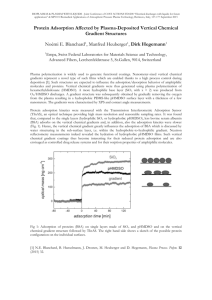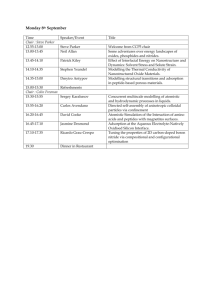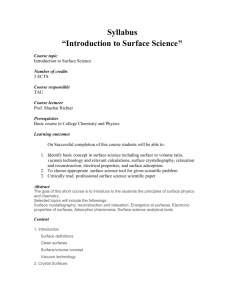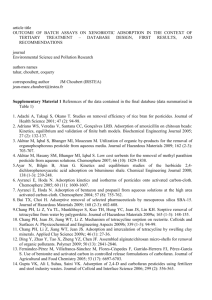jssc4672-sup-0001-SuppMat
advertisement
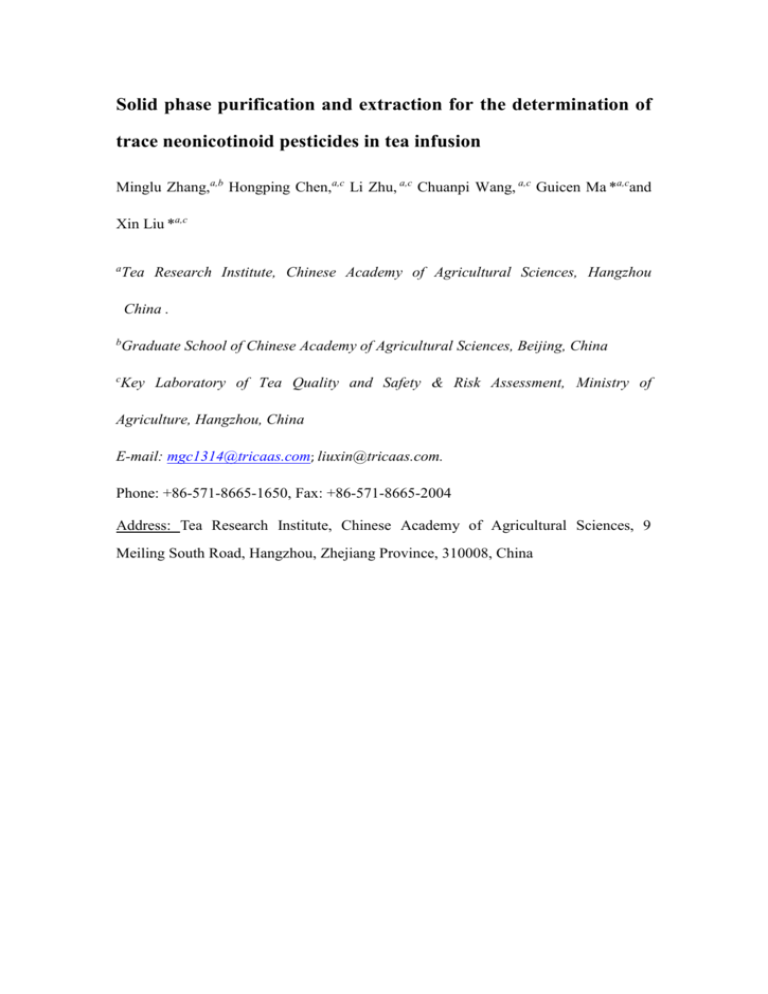
Solid phase purification and extraction for the determination of trace neonicotinoid pesticides in tea infusion Minglu Zhang,a,b Hongping Chen,a,c Li Zhu, a,c Chuanpi Wang, a,c Guicen Ma *a,cand Xin Liu *a,c a Tea Research Institute, Chinese Academy of Agricultural Sciences, Hangzhou China . b c Graduate School of Chinese Academy of Agricultural Sciences, Beijing, China Key Laboratory of Tea Quality and Safety & Risk Assessment, Ministry of Agriculture, Hangzhou, China E-mail: mgc1314@tricaas.com; liuxin@tricaas.com. Phone: +86-571-8665-1650, Fax: +86-571-8665-2004 Address: Tea Research Institute, Chinese Academy of Agricultural Sciences, 9 Meiling South Road, Hangzhou, Zhejiang Province, 310008, China Supporting Information 1 Synthesis 1.1 Synthesis of SBA-15-NH2 Amino functionalized SBA-15 (SBA-15-NH2) was synthesized according to our previous study [1]. Typically, 1.6 g (0.32 mmol) of EO20PO70EO20 (P123) and 2.2 g KCl were dissolved in 60 g of 2.0 M HCl at 40 oC. To this solution, 4.2 g (20mmol) of TEOS was added under vigorous stirring. The final molar-composition of the reactants is 0.02P123/1.5KCl/6 HCl/166 H2O/1TEOS. After stirring for 10 min, the mixture was kept in static conditions at the same temperature for one day, and then the mixture was transferred into an autoclave and heat at 140 oC for another 24 h. The solid product were collected by filtration and dried at 60 oC in air. The obtained samples were calcined at 350 oC before used. For the synthesis of SBA-15-NH2, 0.01mol aminopropyltrimethoxysilane and 3.0 g SBA-15 were added to 60 mL toluene, the mixture was stirred at 110 oC for 12 h, and then the solid was collected by filtration and dried at 60 oC in air. 1.2 Synthesis and characterization of GO GO was synthesized according to a modified Hummers method [2]. Typically, graphite powder (3.0 g), NaNO3 (1.5 g) and 98% H2SO4 (69 mL) were mixed into a 500 mL three-neck flask, KMnO4 (9.0 g) was added slowly to the mixture in constant stirring under the ice bath to controlled the reaction temperature below 5 oC. Then, the solution was stirred for 2 h under 35 oC, and was transferred to the ice bath again. 138 mL of deionized water was gradually added to the mixture. Afterwards, the solution was heated in an oil bath at 96 oC for 30 min, additional deionized water (100 mL) and 30% H 2O2 (3 mL) were added. Finally, the resulting mixture was washed repeatedly with deionized water until the pH was 7, and graphene oxide was obtained after vacuum drying. 2 Adsorption Test 2.1 Crude tea infusion purification with SBA-15-NH2 Dried tea leaves were brewed as follows: 3.0 grams of dried green tea leaves were weighed into a 250 mL flakes and 100 mL of boiled water were added. After 10 min of brewing, the hot aqueous extract was cooled and filtered. Different amounts of SBA-15-NH2 (0, 20, 50,100 mg) were added into 10 mL crude tea infusion. The mixture was shaken for 30 min and centrifuged. The supernatant was collected as tea infusion for further used. 2.2 Calculation of adsorption capacity. Different amount of GO powder (50-200mg) was added into the tea infusion solution (obtained from 2.1. section) with a concentration of pesticide at 0.1 mg L-1. The mixture was shaken for 10 min and centrifuged at 12000 rpm. Then 1 mL of the supernatant was filtered through 0.22 μm PTFE and 3.0 μL was injected into the UPLC-MS/MS system for analysis. The adsorption capacities of target pesticides toward GO were evaluated according to the following equation (eq 1). Adsorption capacity % = (Co-Ct)/C0×100% (eq 1) Co and Ct are the concentrations of pesticides before and after adsorption, respectively. 2.3 Adsorption kinetics. The adsorption kinetics curves of pesticides on GO were studied as the following operation process: 1.5g of GO was added into 100 mL of tea infusion with pesticide (Co = 0.1 mg L-1). Then the mixture was stirring at ambient temperature. Samplings (1.0 mL) were done in specific time intervals (from 0 to 60 min) after the addition of GO. The samples were centrifuged and the concentration of the target pesticides in the supernatants was determined by UPLC-MS/MS. In order to reveal the mechanism of the adsorption process and evaluate the adsorption performance of GO, pseudo-first-order (eq 2) and pseudo-second -order (eq 3) kinetics models were applied to fit the experimental data. In (Qe − Qt) = ln Qe − k1t (eq. 2) t 1 t = 2 + Qt k2Qe Qe (eq. 3) V Q = (Co-Ce) × M (eq. 4) Here, Q represents the adsorption amount of the pesticide on GO which was calculated by equation 4. Where Co and Ce are the initial and equilibrium concentration of pesticide. M is the weight of GO (mg) and V (mL) is the volume of tea infusion. Qe and Qt (mg g-1) are the adsorption amount of pesticide on GO at equilibrium and at any time t respectively. k 1 (min-1) and k2 (g mg-1 min-1) are the rate constants of the pseudo-first-order and pseudo-second-order models, respectively. 2.4 Adsorption isotherm. Tea infusion (10 mL) with different concentrations of target pesticides (Co= 0.05, 0.1, 0.25, 0.4 and 0.5mg L-1) were contacted with GO (100 mg) in conical flasks. The flasks were continually stirring for 30 min under ambient temperature. Then, the concentrations of pesticides in the solutions were analyzed by UPLC-MS/MS. In order to describe the adsorption mechanism, we attempted to fit Langmuir (eq 5) and Freundlich (eq 6) isothermal models to the obtained data. The equations are shown as: Ce Qe Ce = Q m + 1 KLQm 1 In Qe = n InCe + InkF (eq. 5) (eq. 6) Where Qm is the maximum adsorption capacity (mg g-1) and KL is the Langmuir constant related to the adsorption energy (mL mg -1). KF reflects the adsorption capacity of an adsorbent ((mg g-1)(L mg-1)1/n). The parameter n represents the adsorption affinity of the adsorbent for an adsorbate. Ce and Qe are the same as described above. Table S1. Parameters for pesticide residue analysis by UPLC-MS/MS. Pesticide Retention Q1 Mass (m/z) Q3 Mass (m/z) time (min) Thiamethoxam Imidacloprid Acetamiprid Imidaclothiz 4.7 5.4 5.9 5.7 Declustering Collision potential (DP) energy (V) 292.1 211.2 31 18 292.1 181.2 32 29 256.1 209.1 34 22 256.1 175.1 36 22 223.1 126.1 42 27 223.1 56.1 41 25 262.1 181.1 30 20 262.1 131.9 32 27 Table S2. The kinetics parameters for the adsorption of pesticides on GO. Pesudo-second-order Pesticides k2 (g mg-1 Qe (mg g-1) r2 rel error(%) min-1) Thiamethoxam 0.2827 0.00566 0.9996 3.85 Imidacloprid 0.2560 0.00588 0.9993 3.52 Acetamiprid 0.2365 0.00541 0.9988 5.46 Imidaclothiz 0.1203 0.00549 0.9977 7.65 Table S3. The isothermal parameters for the adsorption of pesticides on GO. KF((mg g-1)(L Isotherm Freundlich Pesticides mg-1)1/n) 1/n r2 Thiamethoxam 0.1336 0.8496 0.9952 Imidacloprid 0.1810 0.8116 0.9771 Acetamiprid 0.1378 0.8101 0.9916 Imidaclothiz 0.0908 0.7618 0.9804 Table S4 The results of pesticide residues determined in real samples (mg L-1) Sample ID Thiamethoxam Imidacloprid Acetamiprid Imidaclothiz 1 2 3 4 5 6 7 8 9 10 11 12 13 14 15 16 17 18 19 20 21 22 23 24 25 26 27 28 29 30 ND ND ND ND ND ND ND ND ND ND ND ND ND ND ND ND ND ND ND ND ND ND ND ND ND ND ND ND ND ND ND ND ND ND ND ND 0.0043a ND ND ND ND ND ND ND ND ND ND ND ND ND ND ND ND ND ND ND ND ND ND ND ND ND ND ND ND ND ND ND ND ND ND ND ND ND ND ND ND ND ND ND ND ND ND ND ND ND ND ND ND ND ND ND ND ND ND ND ND ND ND ND ND ND ND ND ND ND ND ND ND ND ND ND ND ND ND ND ND ND ND ND Note: ND=non detection. a The imidacloprid concentration of 100 mL tea infusion brewing from 3 g dried tea is 0.0043 mg L-1. We suppose that the transfer rate is 100% for imidacloprid, the concentration in made tea of imidacloprid is 0.14 mg/kg. Figure S1. Effect of amount of SBA-15-NH2 on the adsorption capacity of GA, C, EGCG and ECG from crude tea infusion. Figure S2. The adsorption isothermals of neonicotinoids on GO at 25 oC. Figure S3. Comparison of the recovery rates of GO, activated carbon, GCB, rGO and raw graphite. Reference [1] Ma G. C., Zhang J. Y., Chen L. Y., Liu T., Yu L. Z., Liu X., Lu C. Y., Rsc Adv. 2014, 4 ,41341-41347. [2] Hummers W. S., Offeman R. E., J. Am. Chem. Soc. 1958, 80,1339-1339.



